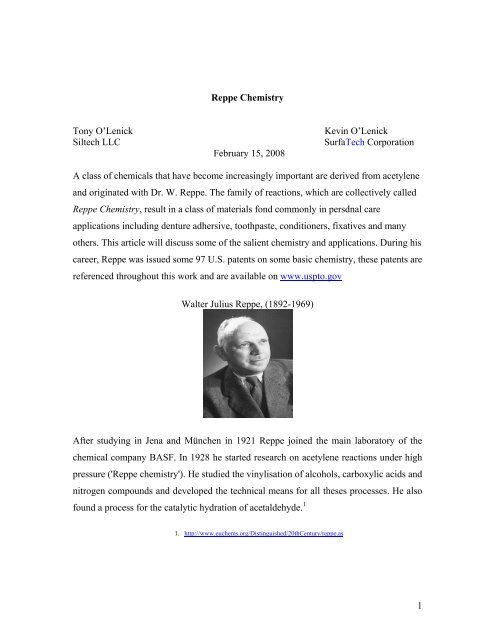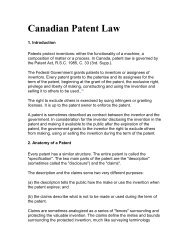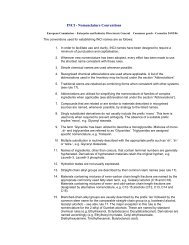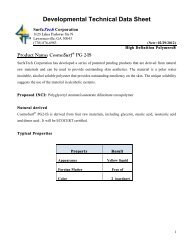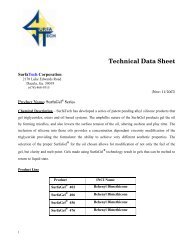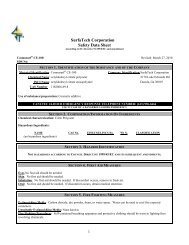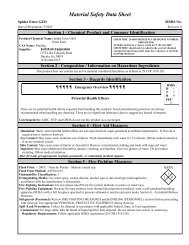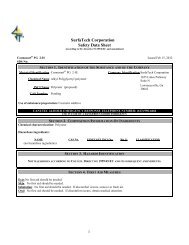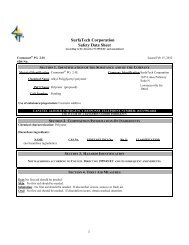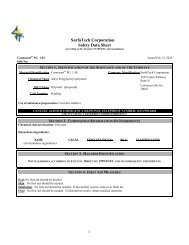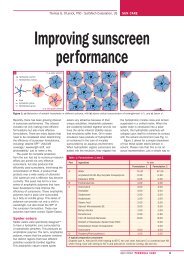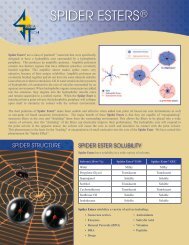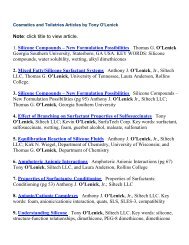Create successful ePaper yourself
Turn your PDF publications into a flip-book with our unique Google optimized e-Paper software.
<strong>Reppe</strong> <strong>Chemistry</strong><br />
Tony O’Lenick<br />
Siltech LLC<br />
February 15, 2008<br />
Kevin O’Lenick<br />
<strong>SurfaTech</strong> Corporation<br />
A class of chemicals that have become increasingly important are derived from acetylene<br />
and originated with Dr. W. <strong>Reppe</strong>. The family of reactions, which are collectively called<br />
<strong>Reppe</strong> <strong>Chemistry</strong>, result in a class of materials fond commonly in persdnal care<br />
applications including denture adhersive, toothpaste, conditioners, fixatives and many<br />
others. This article will discuss some of the salient chemistry and applications. During his<br />
career, <strong>Reppe</strong> was issued some 97 U.S. patents on some basic chemistry, these patents are<br />
referenced throughout this work and are available on www.uspto.gov<br />
Walter Julius <strong>Reppe</strong>, (1892-1969)<br />
After studying in Jena and München in 1921 <strong>Reppe</strong> joined the main laboratory of the<br />
chemical company BASF. In 1928 he started research on acetylene reactions under high<br />
pressure ('<strong>Reppe</strong> chemistry'). He studied the vinylisation of alcohols, carboxylic acids and<br />
nitrogen compounds and developed the technical means for all theses processes. He also<br />
found a process for the catalytic hydration of acetaldehyde. 1<br />
1. http://www.euchems.org/Distinguished/20thCentury/reppe.as<br />
1
1. Acetylene <strong>Chemistry</strong> 2 .<br />
Acetylene (IUPAC name: ethyne) is the simplest alkyne hydrocarbon, consisting of two<br />
hydrogen atoms and two carbon atoms connected by a triple bond. The principal raw<br />
materials for acetylene manufacture are calcium carbonate (limestone) and coal. The<br />
calcium carbonate is first converted into calcium oxide and the coal into coke, then the<br />
two are reacted with each other to form calcium carbide and carbon monoxide:<br />
CaO + 3C → CaC 2 + CO<br />
Calcium carbide (or calcium acetylide) and water are then reacted by any of several<br />
methods to produce acetylene and calcium hydroxide. This reaction was discovered by<br />
Friedrich Wohler in 1862.<br />
CaC 2 + 2H 2 O → Ca(OH) 2 + C 2 H 2<br />
Acetylene<br />
Chemical name Acetylene<br />
Chemical formula C 2 H 2<br />
Molecular mass 26.0373 g/mol<br />
CAS number 74-86-2<br />
Density 1.09670E-03 g/cm 3<br />
Melting point -84 °C<br />
Boiling point -80.8 °C<br />
EINECS<br />
200-816-9<br />
2. http://en.wikipedia.org<br />
2
Since acetylene in mixtures with air containing between 3% and 82% acetylene<br />
are explosive on ignition. The ability to make derivatives of acetylene under high<br />
pressure is no small accomplishment. <strong>Reppe</strong>'s laboratory had acetylene piped in at 30<br />
atmospheres of pressure. First and foremost the process requires the development of safe<br />
method and means of handling acetylene under pressure.<br />
Faced with a lack of availability of H 2 C<br />
CH 2<br />
to make rubber, and an<br />
availability of acetylene HC CH the problem became how can one make an aplha omega<br />
double bond for polymeiization? <strong>Reppe</strong> <strong>Chemistry</strong> provided a potential answer and with<br />
it a series of new products for the [resonal care market. The material was<br />
O O .<br />
4. Reactions of Alcohols and Acetylene – Vinyl Ethers<br />
Dr. <strong>Reppe</strong> and his associates pioneered the now well-known reaction between<br />
acetylene and alcohols. The reaction is applicable to both aliphatic and aromatic alcohols,<br />
primary and secondary alcohols, and phenols. Potassium hydroxide is employed as the<br />
catalyst. Ethers and esters and secondary amines also react with acetylene under<br />
pressure. For example, the reaction between methyl alcohol and acetylene goes very<br />
smoothly at about 200º C. to give methyl vinyl ether in the presence of KOH:<br />
CH 3 OH + HC CH → CH 3 O - CH = CH 2<br />
The importance of this reaction is the introduction of a vinyl group which is used<br />
in subsequent polymerization.<br />
3
5. Phenol – Acetylene Reactions<br />
The reaction of acetylene with phenol, employing KOH as the catalyst, which<br />
gives first phenyl vinyl ether that can convert to vinyl phenol.<br />
OH<br />
CH CH 2<br />
Commercially, Korosin, and adhesive for synthetic rubber, was made by reacting<br />
isobutylphenol with acetylene. This was considered an indispensable development in the<br />
German synthetic rubber program as this material bound the synthetic rubber to the<br />
fabric. It also assists in producing a tire that does not get hot in use.<br />
Vinyl Ether Technology<br />
The following U.S. Patents deal with various aspects of vinyl ether technology;<br />
VE-1 1,941,108<br />
VE-2 1,959,927<br />
VE-3 2,017,355<br />
VE-4 2,021,869<br />
VE-5 2,066,075<br />
VE-6 2,066,076<br />
VE-7 2,118,863<br />
VE-8 2,118,864<br />
VE-9 2,157,347<br />
VE-10 2,157,348<br />
VE-11 2,118,945<br />
VE-12 2,118,946<br />
VE-13 2,153,993<br />
VE-14 2,228,365<br />
VE-15 2,978,450<br />
VE-16 2,716,666<br />
Production of Vinyl Ethers<br />
Production of Vinyl Ethers<br />
Vinyl Ethers<br />
Production of Vinyl Ether<br />
Vinyl Esters of Carboxylic Acids and their Production<br />
Producing Vinyl Ethers<br />
Mixed Polymerization Products<br />
Polymerization Products from Vinyl Esters<br />
Production of Vinyl Ethers Derived from Carbohydrates<br />
Production of Aliphatic Vinyl Ethers by means of Acetylene<br />
Mixed Polymerization Products<br />
Mixed Polymerization Products<br />
Process of Producing N-Vinyl Compounds<br />
Process of Producing Vinyl Esters<br />
Production of Vinyl Compounds<br />
Production of anthranyl vinyl ethers<br />
4
6. Mercaptan Reactions<br />
Mercaptans, react with acetylene to give products analogous to those derived from the<br />
oxygen alcohols.<br />
M-1 2,073,589 Production of Ethane Dithio Ethers<br />
M-2 2,081,766 Thioethers and their Production<br />
M-3 2,094,467 Production of New Thio Ethers<br />
M-4 2,098,759 Production of Thio-Ethers<br />
M-5 2,105,845 Production of Organic Sulphur Compounds<br />
64 3,394,193 Preparation of Mercaptoalkanols<br />
7. Reactions of Aldehydes with Acetylene<br />
Aldehydes including but not limited to formaldehydes, acetaldehyde, propionaldehyde<br />
can be reacted with acetylene under pressure in the presence of metallic acetylides to<br />
form unsaturated alcohols. Either one or two molecules of the employed aldehyde can<br />
react with the acetylene and the so-formed alcohols have as many carbon atoms as are<br />
present in the reacted reagents, for example with acetylene and formaldehyde, there can<br />
be prepared both<br />
(1) Propargyl alcohol HC = C - CH 2 OH<br />
(2) Butine 3 diol 1,4 HOCH 2 - C = C - CH 2 OH<br />
The butanediol 1,4 (n-butylene glycol) can be recovered from the aqueous<br />
solution and be dehydrated in one step to butadiene over a phosphate catalyst.<br />
However, it is preferable because of higher yields and for other reasons according<br />
to Dr. <strong>Reppe</strong>, to dehydrate the butanediol to butadiene in two steps: that is, first to<br />
tetrahydrofuran and then the latter to butadiene.<br />
5
A key concept in the making of compounds via <strong>Reppe</strong> chemistry is the ability to<br />
convert acetylenic bonds ( triple bonds) into ethylenic bonds (double bonds) and into<br />
fully saturated materials. The preparation of saturated compounds is relatively easy and<br />
can be accomplished using standard hydrogenation, but stopping at a double bonded<br />
material is quite a bit more complicated. A series of patents collectively called<br />
Technology for Converting Compounds of the Acetylene Series into Compounds of the<br />
Ethylene Series, was issued to Dr. <strong>Reppe</strong>. Specific catalysts capable of selective reaction<br />
were developed along with processes for their use. Typical are the following patents.<br />
SH-1 2,207,071 Process of Converting Compounds of the Acetylene Series into Compounds<br />
of the Ethylene Series<br />
SH-2 2,207,070 Process of Converting Compounds of the Acetylene Series into Compounds<br />
of the Ethylene Series<br />
SH-2 2,267,749 Process of Converting Dihydroxy compounds of the Acetylene Series into<br />
Dihydroxy Compounds of the Ethylene Series<br />
8. Tetrahydrofuran<br />
Tetrahydrofuran is an important new building block in synthetic chemistry, as<br />
well as a good solvent for many types of compounds including also such high polymers<br />
as polyvinylchloride, polyvinyl carbazol, natural rubber and Buna. It enters many<br />
reactions. Adipic acid can be made from it. In the above aqueous solution of 30-35%<br />
butanediol 1,4, obtained by hydrogenation of the reaction product of formaldehyde and<br />
acetylene, the former can be dehydrated to tetrahydrofuran in said solution by the<br />
addition of a small amount of H 3 PO 4 and maintaining the pH at least 2 and distilling the<br />
mixture at a temperature of about 260-300º C. and a pressure of 60-100 atm; the THF<br />
(tetrahydrofuran) is easily volatilized under these conditions and is quantitatively<br />
produced. The Na and Ca ions in the solution added for control of the pH value are<br />
substituted by H ions and by ion-exchange media (Volfatite). THF<br />
THF-1 2,251,895 Production of Tetrahydrofuranes<br />
THF-2 2,251,835 Production of Tetrahydrofurane from 1,4 – Butylene Glycol<br />
THF-3 2,251,292 Production of Tetrahydrofuranes<br />
6
Butanediol 1,4 is also the starting product for the war time blood plasma<br />
substitute. By oxidation of its hydroxy-groups to aldehydes by simple spraying over a Cu<br />
catalyst at 200º C. by well-known Cannizzaro reaction, there is produced gamma<br />
hydroxybutyric acid and butyrolactone by reaction with liquid ammonia at 250º C. gives<br />
alpha pyrrolidene<br />
9. Lactams<br />
Conversion of pyrrolidon to its potassium salt and the latter's reaction with<br />
acetylene, similarly to the known preparation of vinyl carbazole, gives a N-vinylpyrrolidon<br />
which is the monomer of Periston.<br />
Vinyl Pyrrolidone can be polymerized to Periston by aqueous solution of NaHSO 3<br />
or by oxidation with H 2 O 2 at a temperature of 70-80º C.; the H 2 O 2 is the catalyst and is<br />
employed in amounts of 0.05 to 1% plus NH 3 to the extent of 1/2 to 1/2 of the employed<br />
H 2 O 2 which determines the degree of polymerization. Periston is neutral, has a high<br />
viscosity and is broken down in and eliminated by the human body.<br />
By reaction of NH 3 or amines with THF, it is converted to Pyrrollidine and its N-<br />
substituted products; these products are valuable in insecticides and in vulcanization<br />
acceleration. The dehydrogenation of pyrrollidine gives pyrrol.<br />
Conclusion<br />
Despite the fact that <strong>Reppe</strong> chemistry is rather old, the technology is very impressive as<br />
to what type of products can be made and it’s versitility.<br />
7


